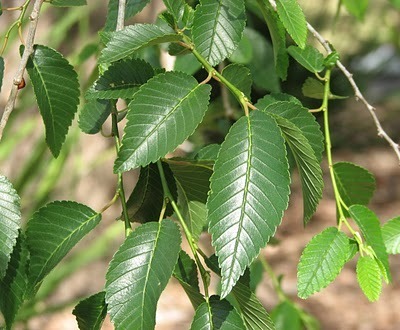Secrets of the Siberian Elm, Part 1 of 2

The Book of Deadly Animals is now on sale in the United Kingdom. To celebrate, I'm running here some expanded version of tales I told in the book. Since the book is strictly about animals, I included just a bit of this piece, about stinging insects. But there's more to the story. . .
When you look at a wall spotted with stains .. . you may discover landscapes beautified with mountains, rivers and rocks,arrayed with trees, plains, hills and wide valleys; you may see battles andfigures in action; or strange faces and costumes, human heads, animals, cliffs,the sea, cloud or forests. And these appear on such walls confusedly, like thesound of bells in whose jangle you may find any name or word you choose toimagine.
Leonardo da Vinci
I stood precariously on a six-foot step-ladder, sawing thelimb of a Siberian elm. The handsaw bitthrough the textured bark in a few smooth strokes, then hit the heartwood andslowed. I tried not to rush. I thought I would actually go faster bykeeping my strokes smooth and long, conserving the strength of my arm. It was boring work. My calves ached with the effort of standingtall enough on my inadequate ladder. Butthe action of the saw was relaxing, even as it wore me out.
My eyes wandered. Thebark of the tree was thick, and thickened further at the collars where limb mettrunk or thicker limb. The bark ofSiberian elms has always suggested faces to me, human faces shaping in thatgator-hide texture--I mix my metaphors, but mixture is what the bark suggeststo me, because where I imagine one face in the bark, it is alwaysincomplete. The curve that wouldcomplete it is absent, and instead some broad ridge sweeps in and draws my eyeto a further face appended to the first face, and this second is incomplete andverges prematurely into two others. If Ilet myself simply gaze at the bark, I wander from face to face until I catchmyself losing everything, following lines without attaching meaning to them,only vague intimations, moods. When Icatch myself drifting away from all sane restraint, I try to find someparticular face again. Perhaps it's aparticularly ugly face; maybe it's one whose eyes gazed back at mine with aparticular intensity. Usually I don'tfind it.
As I sawed, I let my eyes wander along the bark in thismanner. I didn't really take myattention away from what I was doing; Siberian elm bark is so deeply textured,so rich in convolutions, like a human brain, that I can wander for miles withina few inches. But this time somethingstopped me and made my eyes shift their focus toward a shape that did notdissolve into the next one.
Itwas a cockroach, a thin brunet one, and he was acting strangely. He was close enough to feel my breath, but hedidn't run away. I stared at him until Inoticed a deficiency: His antennae, which should have been long and whip-thin,were only blunt stubs. I flashed tosomething I had read, about the habits of a certain predatory wasp, Ampulexfurruginea. The wasp bites a roach'santennae off; that action renders the roach literally senseless, unable tocomprehend the world around him. Itmakes the normally skittish creature docile. The wasp can do with her victim what she will.
As I remembered this unusual set of facts, a wasp crawledinto view, moving at a businesslike clip. She was leaner than a honeybee, half black and half red. She seized the roach by the stubs of hisantennae and led him through the valleys of bark. They traveled only about six inches, though Iimagine the journey was much longer to them, going over ridges and throughcrevasses. The wasp let go of the roachand left. She'd be back. I'd seen the same behavior in themidnight-blue hijacker wasps that dart about on my lawn hunting for spiders. After bringing the prey under their power,they flit between the victim and the grave they mean to seal him in.
The wasp, of whatever species, is a female. She's about to lay an egg, and the finalresting place of her victim--it can be a hole in the ground, or, as in thiscase, a natural crevice in stone or bark--becomes a nursery for her larva. The larva eats the paralyzed prey fromwithin--he becomes shelter and suckle at the same time. The special delight of such arrangements isthat the prey stays alive through most of it. Otherwise, he would rot and be useless as wasp food. The wasp clan has diversified enormously, sothat it can supply parasites tailored for many sorts of living things--treesand tarantulas, caterpillars and beetles. Some wasps parasitize other parasitic wasps, and these hyperparasites inturn are parasitized by other wasps, and these by others. Perhaps this hyperparasitic regression goesfurther, but it's hard to say: at this point, the wasps are too small to beseen without a microscope.

The wasp returned. She was on foot the entire time, never flying. Each time she came back, she would lead theroach a few more inches. I couldn't seethe other end of her round trip, the place she had chosen for him. She led the senseless roach around the trunkand out of my sight. I climbed afterthem a little way, but some idiot had been sawing at the branches, leaving melittle to climb on. I strained my eyesgazing at that infinity of folded faces, which I now realized was also a vastgraveyard and nursery.
Do not marvel at all these strange births andtransformations, for we ourselves are nothing more than caterpillars and worms.
Francesco Redi
THE BOOK OF DEADLY ANIMALS
Published on November 07, 2011 09:30
No comments have been added yet.



